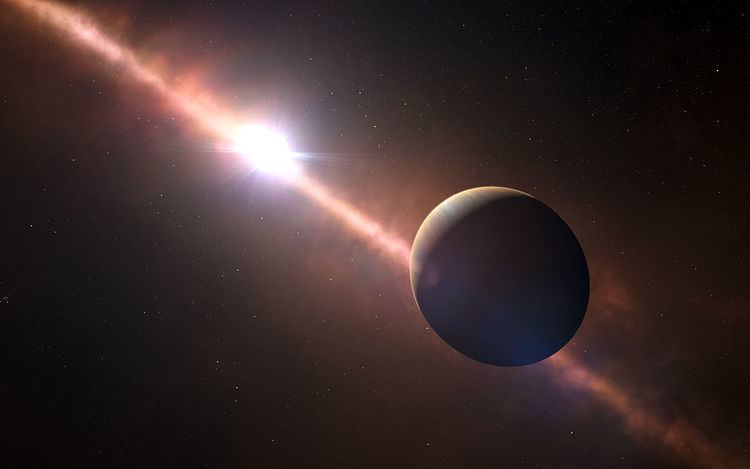[Fe/H] 0.06 Discovery date November 18, 2008 | Projected separation (d) Discoverer(s) Lagrange et al. Discovery status Confirmed | |
 | ||
Beta Pictoris b (also abbreviated as β Pic b) is an exoplanet orbiting the young debris disk A-type main sequence star Beta Pictoris located approximately 63 light-years (19.4 parsecs, or nearly 7014598621400000000♠5.986214×1014 km) away from Earth in the constellation of Pictor. It has a mass around 7 Jupiter masses and a radius around 65% larger than Jupiter's. It orbits at 9 AU from Beta Pictoris (close to the plane of the debris disk orbiting the star) with a low eccentricity and a period of 20–21 years, and is the only known planet in the Beta Pictoris system.
Contents
Mass, radius and temperature
Beta Pictoris b is a super-Jupiter, an exoplanet that has a radius and mass greater than that of the planet Jupiter. It has a temperature of 1,600 K (1,330 °C; 2,420 °F), most likely due to its dusty atmosphere and mass (normally it'd be much colder). It has a mass of around 7 MJ, and a radius of 1.65 RJ.
Host star
The planet orbits an (A-type) star named Beta Pictoris. The star has a mass of 1.75 M☉ and a radius of 1.8 R☉. It has a surface temperature of 8056 K and is 12 million years old. In comparison, the Sun is about 4.6 billion years old and has a surface temperature of 5778 K. It is slightly metal-rich, with a metallicity ([Fe/H]) of 0.06, or 112% of that found in the Sun. It's luminosity (L☉) is 8.7 times that of the Sun.
The star's apparent magnitude, or how bright it appears from Earth's perspective, is 3. Therefore it can be seen with the naked eye.
Orbit
Beta Pictoris b orbits its host star every 21 years at a distance of 9.2 AU (about the same as Saturn's distance, which is about 9.55 AU). It receives 11% of the amount of sunlight that Earth does from the Sun.
Rotational period observation
In 2014, the rotation period of Beta Pictoris b was calculated from the broadening of its carbon monoxide infrared absorption line. This makes it, as of 2015, the first extrasolar planet to have its rotation rate measured.
With a rotation period of 8.1 hours, it is the fastest-spinning planet known. Its rotation period is faster then that of Jupiter, which has a rotation period of around 10 hours.
In 2015, a short video was made from direct images of Beta Pictoris b taken by the Gemini Planet Imager over the course of about two years showing a time-lapse of the planet orbiting around its parent star. It may have been responsible for a transit-like event observed in 1981.
Discovery
The planet was discovered on November 18, 2008 by Lagrange et al., using the NACO instrument on the Very Large Telescope at Cerro Paranal in northern Chile. This planet was discovered using the direct imaging technique, utilizing reference star differential imaging. The discovery image was taken in 2003, but the planet was not detected when the data were first reduced. A re-reduction of the data in 2008 using modern image processing tools revealed the faint point source now known to be a planet.
Further studies
Follow-up observations performed in late 2009 and early 2010 using the same instrument recovered and confirmed the planet, but on the opposite side of the star. These findings were published in the journal Science and represented the closest orbiting planet to its star ever imaged. Observations performed in late 2010 and early 2011 allowed scientists to establish an inclination angle of the planet's orbit of 88.5 degrees, nearly edge-on. The location of the planet was found to be approximately 3.5 to 4 degrees tilted from the main disk in this system, indicating that the planet is aligned with the warped inner disk in the Beta Pictoris system.
The first study of the spectral energy distribution of the planet was published in July 2013. This study shows detections at 1.265, 1.66, 2.18, 3.80, 4.05 and 4.78 µm demonstrating that the planet has a very dusty and/or cloudy atmosphere. The SED is consistent with that of an early L dwarf, but with a lower surface gravity. The effective temperature is constrained to 1700+100
−100 K and the surface gravity to log g = 4.0 +0.5
−0.5. A second study, published in September 2013, provided a new detection at 3.1 µm obtained at the Gemini Observatory along with a reanalysis of previous data. They found the planet to be overluminous in the mid-infrared 3.1 µm band compared to models of early L dwarfs. Models incorporating small dust particles and thick clouds provided the best fit to the SED. The effective temperature is constrained to 1600+50
−25 K and the surface gravity to log g = 3.8 +0.02
−0.02. This fit corresponds to a planet radius of 1.65 times that of Jupiter, arguing that Beta Pictoris b may be younger than its host star (finished forming at 5 Ma).
